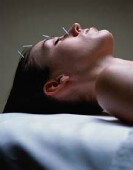
THURSDAY, Nov. 13, 2014 (HealthDay News) — Breast cancer patients who experience pain and swelling related to their treatment may find relief in acupuncture and exercise, new research suggests.
In one study, acupuncture helped reduce joint pain by up to 40 percent, said study author Dr. Jun Mao, director of the integrative oncology program at the Abramson Cancer Center at the University of Pennsylvania, in Philadelphia.
And it didn’t matter if people thought it would work or not, he found.
While other studies have found acupuncture is effective for a variety of symptoms, including joint pain, fatigue and sleeping difficulties, Mao wanted to see the role a person’s expectations of the treatment would have.
He studied 41 breast cancer survivors, assigning them to a sham acupuncture group or an electroacupuncture group, and compared them to a “control group” that got neither treatment. Electroacupuncture uses a small electrical current passed between two pairs of acupuncture needles to stimulate certain points on the body. The women did not know whether they were getting the real treatment or the sham one.
The women had stiffness or joint pain, which are common side effects when taking aromatase inhibitors, a hormonal therapy used to help treat breast cancer.
“What we found is in the real acupuncture, the response was not dependent on whether the patient believed acupuncture to work or not,” Mao said. “However, in the sham group, the response seemed to be driven by the higher expectation of acupuncture to work.”
Those in the real acupuncture group had a consistent level of pain reduction, Mao said. In the sham group, if there was a low expectation, no change in pain was reported. “For those [in the sham group] with extremely high expectations, their effect was as strong as 80 percent,” he said.
Pain relief from real acupuncture is often dismissed as a “placebo effect,” Mao explained. “Our results demonstrate the opposite,” he said. In real acupuncture, expectation plays no role in pain reduction. “The real acupuncture group, regardless of expectation, everyone had about a 40 percent reduction in pain,” he said. A decline of 30 percent or higher is viewed as meaningful, he added.
What this means, Mao said, is that “real acupuncture will work for anyone, whether you believe it or not.”
The study is published in the November issue of the Journal of the National Cancer Institute Monographs.
In the same journal, University of Pennsylvania researchers looked at how a community-based exercise program could help women affected by lymphedema (a swelling of the limbs), muscle problems and decreased body image that can occur after breast cancer.
In a previous study, the researchers had found the program worked in a research setting. But, they wanted to test it in a community setting. The program is administered by physical therapists and included a group-based exercise class and a program for patients to continue at home or at the gym.
In all, 67 breast cancer patients completed measurements of the effects after a year. These participants had improvements in symptoms, body image and muscular strength. The results in the community setting were similar to those that were found in the research setting.
However, the researchers did note issues that were encountered in getting the program operational, including payments, the need for advocates and how to get patients referred so it would be covered by insurance.
The acupuncture study is a solid piece of research, said Leslie Bernstein, director of cancer etiology at the City of Hope Cancer Center, in Duarte, Calif.
However, she said, it’s important to point out that acupuncture won’t work for everyone. “But, on average, it will work,” she said, based on the study results.
The exercise study showed the challenges that come with taking a program that’s been tested and found effective in research settings and putting it into practice, Bernstein added. “It highlighted the issues that one would meet in what works as an intervention, and taking that into the community.”
Among the common issues, she said, are finding someone to administer such programs, paying for them and getting insurance coverage and approvals.
More information
Visit the U.S. National Institutes of Health for more on acupuncture.
Copyright © 2025 HealthDay. All rights reserved.

